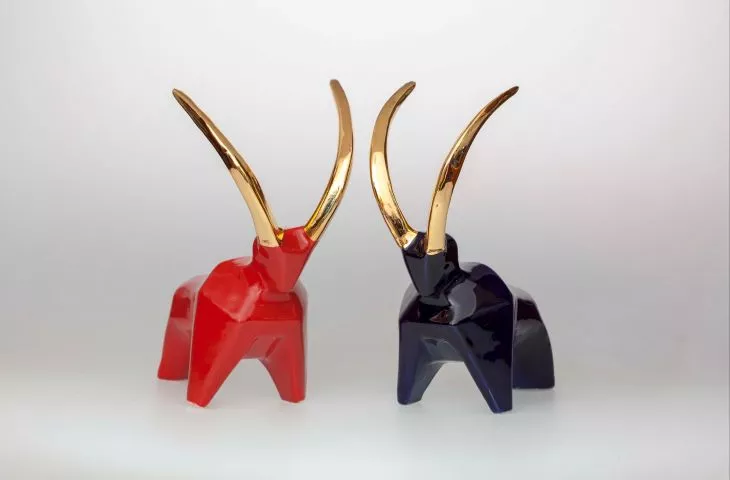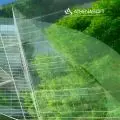The geometric forms of Jakub Niewdana 's animals captivate with their simplicity and vivid colors. Suspended somewhere between art-deco form and pop-art sense of humor, they can be an unconventional addition to an interior or decoration for a collection.
The "Animalium" series by Jakub Niewada consists of figurines of several animals in various sizes and color versions. In this colorful herd zebras, crocodiles, owls, goats, cows, rhinos, sharks and gorillas coexist side by side. The artist highlighted the most typical features of the animals' physiognomy, thus giving each figure a peculiar character. Zebras gently tilt their heads as if they were just plucking grass on the savannah, owls hover motionless, staring with big eyes at their prey, and gorillas freeze in a deafening roar.
from the dawn of time...
"Animalium" fits perfectly into the long tradition of animalistic sculpture. Inspiration by the shapes of fauna has been present in sculpture since Paleolithic times. Figures of buffalo and other game animals were most likely magical in nature and were meant to serve as amulets. Over the following centuries, artists forged animal forms in stone, clayed them and cast them in bronze. However, they were rarely regarded as independent works of art, rather as staffage for larger compositions or as an element of ornament. It was not until the 19th and 20th centuries that animalistic sculpture was given an independent position. With the development of cabinet art and collecting, small-scale sculptures depicting a wide variety of animals became increasingly popular. This is borne out by both the artistic and commercial success of artists such as Antoine-Louis Barye, who paved the way for the Paris Salon with his brass animal figurines.
Jakub Niewdana, Gorillas
© Lipowa 3 Glass and Ceramics Center
...to the present day
Animalistic sculpture was also beloved by the 20th century. Art Nouveau artists drew inspiration from the world of animals by the handful, creating stand-alone sculptures as well as furniture, dishes and jewelry inspired by the shapes of animal bodies. Art-déco, on the other hand, was fond of reducing complex animal shapes to simple geometric solids, which, when combined with details and refined materials, produced an incredibly decorative effect. A master of this type of treatment was François Pompon, whose figure of a walking polar bear has passed into the canon. Also the great avant-garde artists did not shy away from animal shapes. Suffice it to mention Pablo Picasso or Henry Moore.
Art-deco with elements of pop art
Jakub Niewdana fits perfectly into this long line of animalists. In his works one can see artdec thinking in shorthand and detail. The gilded elements of his sculptures bring to mind precisely the decorative forms of the first half of the 20th century. In turn, their vivid colors are very much in the spirit of pop art, its literalism and playing with form. According to Aleksandra Skorek, art historian and curator of Niewdana's exhibition:
After a period of trials and experiments, Jakub Niewdana found a path that he consistently follows. He creates mainly animalistic ceramic sculptures, characterized by synthetic, geometric forms and sophisticated colors, often decorated with gold and platinum. Zebras, rhinos, crocodiles, sharks, goats and, above all, gorillas, full of strength and expression, are a mixture of art-deco sophistication, African simplicity and pop-art humor. The patterns developed by the artist come in different color variations, catching the eye with fiery red, juicy green or powder pink.
Rhinoceros, Jakub Niewdana
© Lipowa 3 Glass and Ceramics Center
active artist
Jakub Niewdana is a sculptor and photographer of the young generation from Brzezie near Krakow. In 2014, he graduated with honors from the Academy of Fine Arts in Krakow. In the same year he received the Scholarship of the Minister of Science and Higher Education. In 2015, he began doctoral studies at the Pedagogical University of Cracow (currently with an open doctoral dissertation). In addition to his scientific activities, he is also involved in the work of the association "Ceramics Without Borders", of which he is a co-founder, as well as the art group "Vera Icon", which brings together Christian artists. He has participated in numerous exhibitions in Poland and abroad. Since 2015 he has been running his own ceramics studio.
Jakub Niewdana's works from the "Animalium" series can be seen at the exhibition at the Lipowa 3 Glass and Ceramics Center until October 21, 2020.The text was created in cooperation with the Lipowa 3 Glass and Cer amics Center (Łukasiewicz - Institute of Ceramics and Building Materials). The partner of the exhibition is the Malopolska Region



























